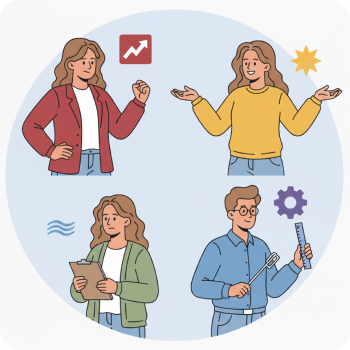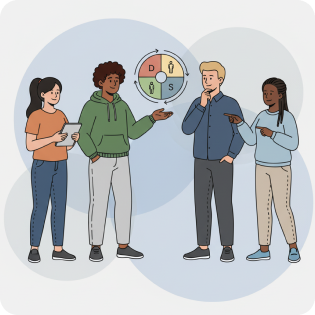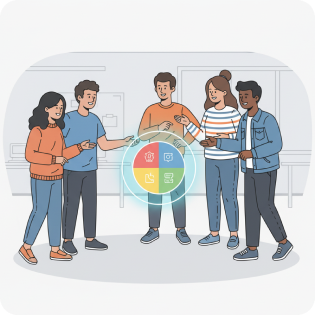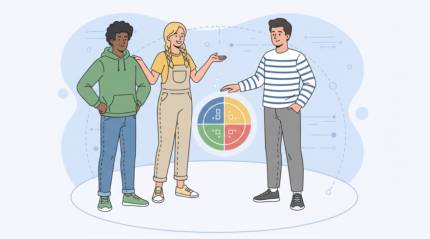DISC Assessment: Transform Workplace Behavior
Understanding behavior at work can transform hiring, collaboration, and leadership, because clarity about how people prefer to communicate and make decisions reduces friction. The framework known for mapping behavioral tendencies offers a pragmatic lens that anyone can use, from first-time managers to seasoned executives. Rather than boxing people in, it helps decode patterns that surface under pressure or during routine tasks, making it easier to tailor feedback, craft roles, and set expectations. With a shared language in place, teams gain momentum, because misinterpretations turn into actionable insights and conflict gives way to productive debate.
-
![]() Build a shared language that streamlines collaboration.
Build a shared language that streamlines collaboration. -
![]() Reduce interpersonal friction by decoding behavioral cues.
Reduce interpersonal friction by decoding behavioral cues. -
![]() Improve role fit and onboarding with clearer expectation
Improve role fit and onboarding with clearer expectation
Master Collaboration and Leadership Using the DISC Model
Across industries, organizations adopt this approach to build a consistent vocabulary for behavior, influence, and motivation. Within many talent programs, the phrase DISC assessment refers to a structured questionnaire that produces a clear snapshot of preferred styles, which then informs development plans and coaching goals. Practitioners value the lineage of the research, yet they also embrace modern updates that emphasize context and situational agility, providing nuance beyond simple labels. As a practical shorthand, the underlying DISC model helps people anticipate how colleagues might respond to change, deadlines, or new information, encouraging better planning and more empathetic leadership.

Beyond hiring and teamwork, this lens improves self-awareness, which is the foundation of any sustainable career. Individuals often experience an “aha” moment when they recognize strengths they had unconsciously relied on for years, and they learn how to flex when those same strengths become overused. In daily collaboration, using insights about DISC personality can help rewrite meeting agendas, reshape communication norms, and guide the cadence of decision-making, since people bring different energy to persuasion, analysis, and follow-through.
The Four DISC Styles: Thrive Under Calm and Stress
When people read their narrative results, many appreciate how a DISC profile can validate instincts while illuminating blind spots that were hiding in plain sight. Interpreters often prompt reflection with questions about triggers, preferred collaboration styles, and the kinds of projects that unlock peak performance. These conversations frame growth not as a personality makeover, but as strategic flexing in service of results.
| Dimension | Behavioral Signals | Stress Triggers | Thrives When |
|---|---|---|---|
| Dominance | Decisive voice, direct requests, fast choices | Slow processes, excessive rules, ambiguity | Goals are clear, autonomy is high, obstacles are removed |
| Influence | Expressive tone, social energy, storytelling | Isolation, rigid structures, muffled recognition | Ideas are welcome, collaboration is frequent, pace is lively |
| Steadiness | Patient cadence, supportive focus, reliable follow-through | Sudden change, conflict spikes, rushed timelines | Rhythms are predictable, trust is strong, needs are heard |
| Conscientiousness | Analytical questions, precision, quality standards | Vague criteria, sloppy data, arbitrary decisions | Details are respected, time is protected, criteria are explicit |
Facilitators often introduce structured debriefs that map communication tactics to each style, using examples from recent projects. The term DISC analysis is frequently used to describe a deeper read of pattern intensity, stress responses, and the interplay between natural and adapted behaviors during change. When someone reviews a DISC personality profile, they may identify two or three micro-habits to apply immediately, like adjusting the level of detail in written updates or pausing to ask clarifying questions during fast-paced debates.

Enhance Team Clarity
In team diagnostics, many groups adopt a shared visual summary to quickly see distribution of styles across functions and roles. Within that context, a well-constructed DISC workplace profile helps pinpoint handoffs that require extra clarity, such as between sales and operations or engineering and support. Managers also gain clarity on where conflict originates, whether from pace differences, conflicting priorities, or clashing definitions of “done.” By spotlighting patterns, the instrument makes invisible dynamics visible.
Start the Test-
![]() Clarify role expectations with behavioral success markers.
Clarify role expectations with behavioral success markers. -
![]() Design meetings that balance pace, detail, and debate.
Design meetings that balance pace, detail, and debate. -
![]() Map project risks to communication and decision styles.
Map project risks to communication and decision styles.
Master Decision-Making With DISC Leadership Insights
Leaders use targeted tools to refine decision-making, influence, and coaching rhythms, and they frequently rely on a specialized DISC leadership assessment to personalize development paths. For example, a senior manager might learn to temper speed with clearer criteria, or to invite dissenting views earlier in their process. These insights translate into measurable practices, like structured pre-mortems for major initiatives and concise readouts that respect different information needs.

In high-volume hiring or large cohorts, talent teams often rely on secure, validated questionnaires to streamline implementation at scale. When an organization references a DISC assessment test, it typically means a standardized instrument administered under guidelines that protect privacy and data integrity. For occasional use cases or pilots, some teams compare shorter screeners with a full DISC test, weighing trade-offs between speed and depth before deciding how to proceed.

Practical DISC Training for Success
Learning leaders craft programs that blend live instruction, experiential exercises, and post-session practice, ensuring the content survives beyond the classroom. Many organizations pair workshops with ongoing DISC training, such as manager huddles that dissect real scenarios or peer coaching circles that reinforce accountable follow-through. The most successful cohorts avoid jargon and stick to plain, practical tactics tied to actual business priorities, which reinforces adoption.
Start the Test-
![]() Align on goals and data standards before rollout.
Align on goals and data standards before rollout. -
![]() Blend workshops with coaching and micro-habits.
Blend workshops with coaching and micro-habits. -
![]() Create playbooks that translate insight into scripts.
Create playbooks that translate insight into scripts.
How a DISC Assessment Improves Team Performance
Implementation teams should choose valid instruments and clear debrief structures that connect insights to role realities. After people receive a DISC profile assessment, facilitators can guide them to select two behavior shifts to experiment with during upcoming projects, then revisit outcomes after a sprint. When leaders opt for a comprehensive DISC personality assessment, they gain a refined view of natural and adapted patterns, which helps them prepare for high-stakes conversations or complex stakeholder maps.
Take DISC Assessment to Decode Your Personality Profile
Get StartedSustain Impact With DISC Test
Organizations sometimes chase novelty and neglect reinforcement, which causes enthusiasm to fade and cynicism to grow. Budget decisions can also skew toward one-time workshops rather than sustained support, undermining long-term impact. For pilots or early-stage programs, some teams consider a curated DISC assessment free option to introduce concepts, then graduate to validated enterprise instruments once value is proven. When budgets are limited, teams can still anchor behavior change through rituals like feedback cadences.
Start the Test
-
![]() Never use behavioral tools as sole hiring criteria.
Never use behavioral tools as sole hiring criteria. -
![]() Protect privacy with clear data governance.
Protect privacy with clear data governance. -
![]() Invest in reinforcement, not just one-time events.
Invest in reinforcement, not just one-time events.
Closing Remarks
Finally, leaders should be wary of oversimplification and stereotyping, especially under time pressure. Modern enablement blends empathy with data and uses structured debriefs to keep conversations grounded. For individual learners seeking practice outside formal programs, a reputable DISC personality test free resource may offer a basic orientation that supports reflection, though it should be paired with coaching to translate insight into action.
Frequently Asked Questions
- How accurate is this behavioral framework?Validity depends on the quality of the questionnaire, the rigor of norming samples, and the skill of facilitators who debrief results. Well-constructed instruments offer strong reliability, but the most accurate insights emerge when participants answer candidly and reflect on context, including role demands and team norms. Treat outputs as starting points for conversation, not definitive conclusions.
- Can it help with remote and hybrid teamwork?Yes, because distributed collaboration amplifies differences in pace, detail, and communication preferences. Teams can codify meeting patterns, documentation standards, and decision gates that respect varying needs. Leaders who explicitly discuss preferences reduce friction in asynchronous work, improve handoffs, and accelerate clarity.
- Should managers use it during hiring?It works best as a supplemental input rather than a gate. Pair behavioral insights with structured interviews, work samples, and reference checks. Focus on role fit, onboarding support, and coaching plans, and ensure candidates understand how their information will be used and protected.
- How often should people revisit their results?Revisiting annually is common, while major role changes or organizational shifts may warrant a fresh read sooner. Because behavior adapts to context, periodic reflection helps people refine habits, especially when team composition or strategy evolves. Ongoing coaching sessions turn insights into durable routines.
- What makes a rollout stick?Successful programs align to clear business outcomes, integrate practice into daily workflows, and provide simple tools that people can apply under pressure. Sponsorship from senior leaders, credible facilitation, and measurement of behavior change all contribute to lasting impact. The combination of clarity, repetition, and feedback builds real capability.
The Latest News
 Complete Guide to the DISC Model: Practical Insights and Real-World Application The DISC model offers a clear lens for interpreting everyday behavior, blending observable tendencies with situational context to reveal how people communicate, make decisions, and respond to pressure. Rooted in behavioral science, this framework segments tendencies into four broad styles, helping r...
Complete Guide to the DISC Model: Practical Insights and Real-World Application The DISC model offers a clear lens for interpreting everyday behavior, blending observable tendencies with situational context to reveal how people communicate, make decisions, and respond to pressure. Rooted in behavioral science, this framework segments tendencies into four broad styles, helping r... - 12 October, 2025
- A Complete Guide to the DISC Framework: Insights, Benefits, and Practical Use The DISC framework is a pragmatic lens for understanding how people prefer to act, interact, and make decisions. Rooted in behavioral science, it clusters day-to-day tendencies into four familiar styles that are easy to recognize under pressure and in calm conditions alike. Leaders value it because...
- 11 October, 2025
- Unlock Behavior Insights With a Complete Guide to the DISC Model The DISC framework translates observable behavior into a practical language, mapping how people communicate, decide, and collaborate. Originating from the research of psychologist William Moulton Marston, the model focuses on four dimensions: Dominance, Influence, Steadiness, and Conscientiousness....
- 10 October, 2025
Please Note
This website (disc-personality-assessment.net) is not an official representative, creator or developer of this application, or product. All the copyrighted materials belong to their respective owners. All the content on this website is used for educational and informative purposes only.


